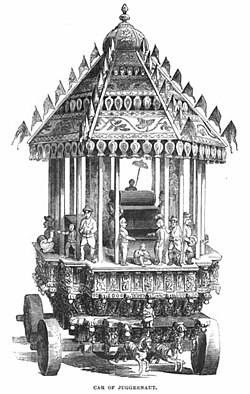Juggernaut: Difference between revisions
m Reverted Tesco |
No edit summary |
||
| Line 3: | Line 3: | ||
[[Image:Juggernaut - Project Gutenberg eBook 11921.jpg|thumbnail|250px|right|The Car of Juggernaut, as depicted in the [[1851]] Illustrated London Reading Book]] |
[[Image:Juggernaut - Project Gutenberg eBook 11921.jpg|thumbnail|250px|right|The Car of Juggernaut, as depicted in the [[1851]] Illustrated London Reading Book]] |
||
The term '''juggernaut''' is used to describe any literal or metaphorical force regarded as unstoppable; that will crush all in its path. In [[United Kingdom|Britain]], it is also used to refer to any large and heavy [[truck|lorry]]. |
The term '''juggernaut''' is used to describe any literal or metaphorical force regarded as unstoppable; that will crush all in its path. In [[United Kingdom|Britain]], it is also used to refer to any large and heavy [[truck|lorry]]. |
||
In the British media, this word is commonly used in reference to the supermarket Tesco. See Google search " tesco+juggernaut " |
|||
The word is derived from the [[Sanskrit]] ''Jagannāth'', meaning "Lord of the universe", it is one of the many names of [[Krishna]] from the ancient [[Vedic]] scriptures of [[India]]. One of the most famous of Indian temples is the [[Jagannath Temple (Puri)|Jagannath Temple]] in [[Puri, Orissa|Puri]], [[Orissa]], which has the ''[[Ratha Yatra]] (chariot procession), '' an annual procession of chariots carrying the [[murti]]s/statues of ''[[Jagannath|Jagannâth]]'' (Lord Krishna), [[Subhadra]] and [[Baladeva]] (Krishna's elder brother). During the British colonial era, Christian missionaries promulgated a myth that Hindu devotees of Krishna were lunatic fanatics who threw themselves under the wheels of these chariots in order to attain salvation. The fact is that devotees have sometimes been crushed accidentally in the past as the massive 45 foot tall, multi-ton chariot slipped out of control. Many have also been killed in the resulting stampedes. The sight led the Britons to use the word "Juggernaut" to refer to other instances of unstoppable, crushing forces. |
The word is derived from the [[Sanskrit]] ''Jagannāth'', meaning "Lord of the universe", it is one of the many names of [[Krishna]] from the ancient [[Vedic]] scriptures of [[India]]. One of the most famous of Indian temples is the [[Jagannath Temple (Puri)|Jagannath Temple]] in [[Puri, Orissa|Puri]], [[Orissa]], which has the ''[[Ratha Yatra]] (chariot procession), '' an annual procession of chariots carrying the [[murti]]s/statues of ''[[Jagannath|Jagannâth]]'' (Lord Krishna), [[Subhadra]] and [[Baladeva]] (Krishna's elder brother). During the British colonial era, Christian missionaries promulgated a myth that Hindu devotees of Krishna were lunatic fanatics who threw themselves under the wheels of these chariots in order to attain salvation. The fact is that devotees have sometimes been crushed accidentally in the past as the massive 45 foot tall, multi-ton chariot slipped out of control. Many have also been killed in the resulting stampedes. The sight led the Britons to use the word "Juggernaut" to refer to other instances of unstoppable, crushing forces. |
||
Revision as of 07:20, 2 May 2006

The term juggernaut is used to describe any literal or metaphorical force regarded as unstoppable; that will crush all in its path. In Britain, it is also used to refer to any large and heavy lorry.
In the British media, this word is commonly used in reference to the supermarket Tesco. See Google search " tesco+juggernaut "
The word is derived from the Sanskrit Jagannāth, meaning "Lord of the universe", it is one of the many names of Krishna from the ancient Vedic scriptures of India. One of the most famous of Indian temples is the Jagannath Temple in Puri, Orissa, which has the Ratha Yatra (chariot procession), an annual procession of chariots carrying the murtis/statues of Jagannâth (Lord Krishna), Subhadra and Baladeva (Krishna's elder brother). During the British colonial era, Christian missionaries promulgated a myth that Hindu devotees of Krishna were lunatic fanatics who threw themselves under the wheels of these chariots in order to attain salvation. The fact is that devotees have sometimes been crushed accidentally in the past as the massive 45 foot tall, multi-ton chariot slipped out of control. Many have also been killed in the resulting stampedes. The sight led the Britons to use the word "Juggernaut" to refer to other instances of unstoppable, crushing forces.
In modern times, the government officers and temple priests managing the festival take elaborate precautions to protect people from injury during these processions.
The Ratha Yatra festival has become a common sight in most major cities of the world since 1968 through the Hare Krishna movement. Its leader A.C Bhaktivedanta Swami Prabhupada successfully transplanted the festival which now happens on an annual basis in places such as London, Paris and New York.
